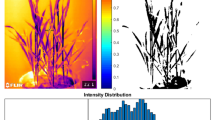Abstract
Concentrations of Ni were determined in xylem and phloem of Quercus ilex trees growing on serpentine and sandy loam soils of northeast Portugal. Radial distribution patterns of Ni in stemwood were compared to variations in annual growth increments of the trees.
Concentrations of Ni in xylem and phloem were higher in Q. ilex from serpentine soil, when compared with Q. ilex of a sandy loam soil.
The radial distributions of Ni showed large variations among the trees, although they all grew in the same area within a short distance from each other. These differences can be caused by small-scale spatial variations in the soil. Therefore, the use of such radial Ni distributions for a retrospective biomonitoring of the Ni pollution of larger areas appears questionable.
Similar content being viewed by others
References
Aniol R W 1983 Tree-ring analysis using CATRAS. Den-drochronologia 1, 45–53.
Arianoutsou M, Rundel P W and Berry W L 1993 Serpentine endemics as biological indicators of soil elemental concentrations. In Plants as Biomonitors. Ed. B Markert. pp 179–189. VCH Weinheim, New York, USA.
BaesIII C F and McLaughlin S B 1984 Trace elements in tree rings: evidence of recent and historical air pollution. Science 224, 494–497.
Brooks R R 1987 Serpentine and its Vegetation: A multidisciiplinary Approach. Dioscorides Press, Portland, OR. 454 p.
Burton M A S 1985 Tree rings. In Historical Monitoring. A technical report. pp 175–202. Monitoring and Assessment Research Centre. University of London, UK.
Cutter B E and Guyette R P 1993 Anatomical, chemical and ecological factors affecting tree species choice in dendrochemistry studies. J. Environ. Qual. 22, 611–619.
Ferreti M, Udisti R and Barbolani E 1992 A new approach to experimental data evaluation from free ring analysis. Ionchromatographic determinations of P, Cl and S. Fresenius J. Anal. Chem. 343, 607–611.
Ferreti M, Udisti R and Barbolani E 1993 Mineral nutrients and trace metals in tree rings of Pinus sp. Fresenius J. Anal. Chem. 347, 467–470.
Hagemeyer J 1993 Monitoring trace metal pollution with tree rings: a critical reassessment. In Plants as Biomonitors. Ed. B Markert. pp 541–563. VCH Weinheim, New York, USA.
Hagemeyer J, Lüfsmann A, Perk M and Breckle S-W 1992 Are there seasonal variations of trace elements (Cd, Pb, Zn) in wood of Fagus trees in Germany? Vegetatio 101, 55–63.
Hagemeyer J, Schäfer H and Breckle S-W 1994 Seasonal variations of nickel concentrations in annual xylem rings of beech trees (Fagus sylvatica L.). Sci. Total Environ. 145, 111–118.
Kudo A, Suzuki T, Santry D C, Mahara Y, Miyahara S and Garrec J P 1993 Effectiveness of tree rings for recording Pu history at Nagasaki Japan. J. Environ. Radioact. 21, 55–63.
McClenahen J R, Vimmerstedt J P and Scherzer A J 1989 Elemental concentrations in tree rings by PIXE: statistical, variability, mobility, and effects of altered soil chemistry. Can. J. For. Res. 19, 880–888.
Meisch H-U, Kessler M, Reinle W and Wagner A 1986 Distribution of metals in annual rings of the beech (Fagus sylvatica) as an expression of environmental changes. Experientia 42, 537–542.
Menezes de Sequeira E and Pinto da Silva A R 1992 Ecology of serpentinized areas of north-east Portugal. In The Ecology of Areas with serpentinized Rocks. A World View. Eds. B A Roberts and J Proctor. pp 1–73. Kluwer Academic Publishers. Dordrecht, the Netherlands.
Momoshima N and Bondietti E A 1990 Cation binding in wood: applications to understanding historical changes in divalent cation availability to red spruce. Can. J. For. Res. 20, 1840–1849.
Momoshima N and Bondietti E A 1994 The radial distribution of 90Sr and 137Cs in trees. J. Environ. Radioact. 22, 93–109.
Pinto da Silva A R 1970 A flora e a vegetação das áreas ultrabásicas do Nordeste Transmontano. Subsídios para o seu estudo. Agronomia Lusitana 30, 175–364.
Proctor J and Woodell S R J 1975 The ecology of serpentine soil. Adv. Ecol. Res. 9, 256–347.
Ragsdale H L and Berish C W 1988 The decline of lead in tree rings of Carya spp. in urban Atlanta. GA, USA. Biogeochem. 6, 21–29.
Sauter J J 1982 Transport in Markstrahlen. Ber. Deut. Bot. Ges. 95, 593–618.
Stewart C M 1966 Excretion and heartwood formation in living trees. Science 153, 1068–1074.
Yanosky T M and Vroblesky D A 1992 Relation of nickel concentrations in tree rings to groundwater contamination. Water Resour. Res. 28, 2077–2083.
Author information
Authors and Affiliations
Rights and permissions
About this article
Cite this article
Nabais, C., Freitas, H., Hagemeyer, J. et al. Radial distribution of Ni in stemwood of Quercus ilex L. trees grown on serpentine and sandy loam (umbric leptosol) soils of NE-Portugal. Plant Soil 183, 181–185 (1996). https://doi.org/10.1007/BF00011433
Received:
Accepted:
Issue Date:
DOI: https://doi.org/10.1007/BF00011433




